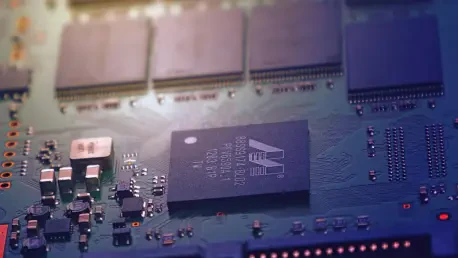In today’s rapidly evolving tech landscape, staying ahead of the curve is essential. We are fortunate to have Oscar Vail, a seasoned expert in technology and emerging fields such as quantum computing and robotics, with us to offer insights into AMD’s exciting developments. Known for consistently being at the forefront of industry advancements, Oscar will dive into AMD’s highly anticipated innovations for the coming years.
Can you provide an overview of AMD’s upcoming Zen 6-based processor, codenamed “Venice”?
AMD’s Zen 6-based processor, “Venice,” is set to be a game-changer in the tech industry. It features a 2nm process and can pack up to 256 cores, marking a 33% increase over the current EPYC ‘Turin’ processors. This leap in core count underscores AMD’s commitment to enhancing compute power, particularly in AI applications.
How does the Venice CPU compare to the current generation EPYC ‘Turin’ processor in terms of core count and performance?
Venice significantly outpaces the Turin processors with a 70% jump in compute performance. This is chiefly due to its increased core count—up to 256 compared to Turin’s capacity—and optimized architecture designed to cater to the ever-growing demands of AI and data processing tasks.
Could you explain the significance of the 2nm process used in the Venice CPU?
The 2nm process is a critical advancement, allowing for more transistors on the chip, which boosts performance while improving power efficiency. This miniaturization paves the way for higher computational density, which is vital for handling demanding AI workloads efficiently.
How does AMD plan to double the memory bandwidth in the Venice CPU compared to current EPYC CPUs?
AMD is doubling the memory bandwidth using a combination of architectural tweaks and cutting-edge memory technologies. This results in achieving a staggering 1.6TB/s per socket, ensuring that CPUs can handle larger data sets and support high-throughput data center applications.
What are the expected benefits of having PCIe Gen6 support in the Venice CPU?
With PCIe Gen6, Venice will offer markedly faster communication speeds between CPUs and GPUs. This leap forward is crucial for data-intensive applications, ensuring smoother and quicker data transfer, which directly impacts overall system performance, particularly in AI workloads.
Lisa Su mentioned improvements in total cost of ownership with Venice. Could you elaborate on these improvements?
Total cost of ownership improvements often involve enhancing performance per watt while reducing operational costs. Venice achieves this through its efficient architecture and increased core performance, which minimizes energy consumption and maximizes processing power over previous generations.
How does the Venice CPU enhance GPU and memory bandwidth to support the MI400 at rack scale?
To support MI400 GPU requirements, Venice has been engineered to double both GPU and memory bandwidth. These enhancements allow for seamless data flow, maintaining high throughput and minimizing bottlenecks, especially when operating at full capacity in data centers.
What are the anticipated advancements AMD aims to achieve by 2027 with Verano CPUs and Instinct MI500-series GPUs?
By 2027, AMD aims to further push the boundaries of AI processing with Verano CPUs and Instinct MI500-series GPUs, striving for unprecedented performance, efficiency, and scalability. These innovations are projected to vastly improve AI capabilities across industries.
How will the 2027 AI rack configuration differ from the current Helios rack setup?
The 2027 AI rack is designed to be more expansive, incorporating 144 MI500 GPUs compared to Helios’s 72. This expanded setup will allow for twice the processing density and potential, catering to even more demanding AI tasks and larger data processing needs.
Considering the informal naming of the 2027 rack, can you discuss how it evolves from the Helios system?
The next-generation rack, informally building on Helios’s platform, signifies a shift towards larger-scale deployments, offering increased computational capacity and enhanced networking capabilities. This evolution reflects AMD’s forward-thinking approach to AI and data center expansion.
How does AMD plan to maintain or improve performance efficiency with the upcoming Verano platform?
The Verano platform is expected to continue the path set by Venice, focusing on maximizing performance while maintaining energy efficiency. This strategy involves leveraging architectural advances and new materials to enhance power management and heat dissipation.
Could you discuss the scalability aspects AMD is focusing on for the 2027 platform?
Scalability is central to AMD’s 2027 strategy. Tailoring hardware to efficiently scale with increasing computational demands ensures that data centers can expand operations without compromising performance, addressing the growing necessity for powerful, flexible computing solutions.
What are some of the anticipated use cases or industries that might benefit most from AMD’s 2027 AI rack?
Industries like healthcare, finance, and autonomous driving stand to benefit greatly from AMD’s powerful 2027 AI rack. These sectors require immense processing power for real-time decision-making and data analysis, tasks perfectly suited for AMD’s advanced AI solutions.
Can you highlight any strategic reasons behind AMD’s decision to discontinue its quad-core server CPU line-up?
Discontinuing the quad-core CPU line-up likely reflects AMD’s focus on high-performance, multi-core processors capable of tackling complex tasks. This shift positions AMD to maintain leadership in the growing data center market where high core counts are increasingly essential.
What kind of response has AMD received from the technology community regarding the announcement of its 2027 innovations?
The tech community has largely responded with enthusiasm and anticipation to AMD’s announcements. By pushing technological boundaries with each new release, AMD continues to capture the industry’s attention and set benchmarks for innovation and development.
What is your forecast for AMD’s future in AI and data processing?
Looking ahead, AMD seems poised to cement its role as a leader in AI and data processing, driven by ongoing innovation and expanding capabilities. With each new platform, they are set to redefine what’s possible, continually adapting to the demands of the future tech landscape.









